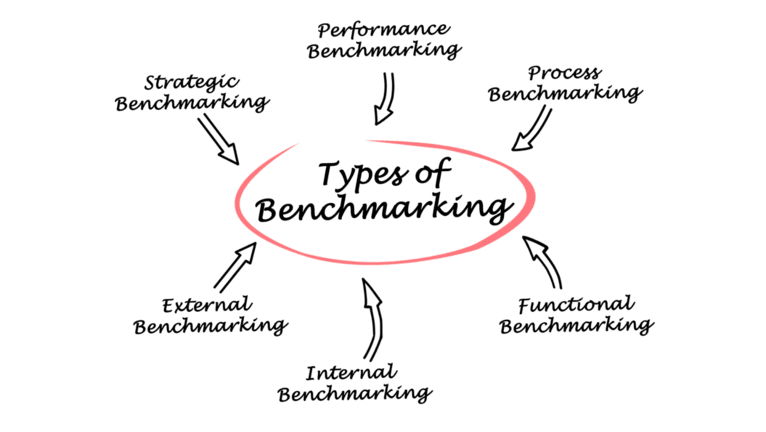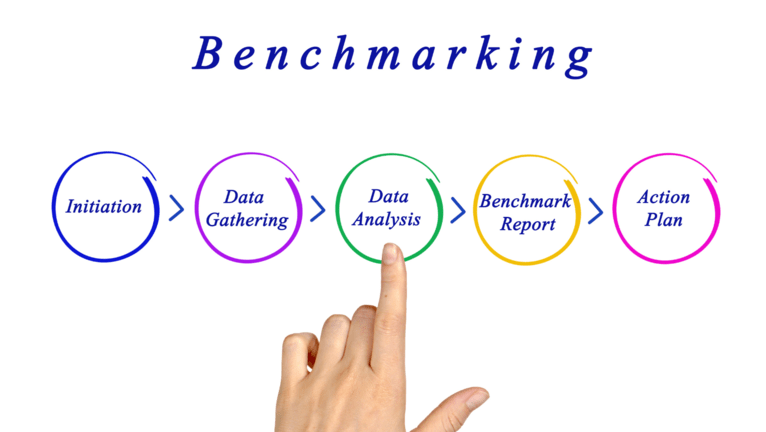Benchmarking definition
If you need to know a short benchmarking definition, it means to compare performance between companies and organizations or industry standards.
Benchmarking measures and compares an organization's performance, processes, and products against other organizations in the same industry or sector. It aims to identify areas where an organization can improve and identify best practices and performance metrics to help achieve superior performance.

Contents
What is benchmarking?
A more elaborated definition of benchmark is that it measures and compares an organization's performance, processes, and products against other organizations in the same industry or sector. Benchmarking aims to identify areas where an organization can improve and identify best practices and performance metrics to help achieve superior performance.
Benchmarking is a strategic process businesses use to improve their performance and achieve their goals. Strategic benchmarking involves identifying and studying the best practices of industry leaders and competitors to implement them in one's own business. This allows companies to set realistic goals and develop effective strategies.
Businesses also use practice benchmarking to learn from other companies and adopt best practices. This involves studying the practices of other businesses in the same industry and identifying areas for improvement. By doing so, companies can improve their practices and stay competitive.
Improved business performance can be achieved by benchmarking through the identification of best practices, the adoption of new practices, and the continuous monitoring of performance metrics. This helps businesses better understand their strengths and weaknesses and identify areas to improve efficiency and effectiveness.
Benchmarking is not just limited to the private sector; it can also be applied in the public sector. Public sector benchmarking is used to identify areas where government agencies can improve their services and operations. This allows them to provide better services to citizens and efficiently use public resources.
Project management is another area where benchmarking is frequently used. Project management benchmarking involves comparing the performance of a project against established benchmarks to identify areas where improvements can be made. This helps to ensure that projects are completed on time, within budget, and to the desired quality standards.
What’s the purpose of benchmarking?
Benchmarking aims to identify areas where an organization can improve its operations and increase efficiency.
It is an essential tool for companies in the technology industry to evaluate their products and stay competitive through continuous improvements. By identifying areas for improvement and comparing their products to industry standards and competitors, companies can make strategic decisions to optimize their products and improve their market position.

Benchmarking resources refer to the tools, data, and information needed to conduct a benchmarking study. These resources can include industry reports, performance metrics, and other data sources that help organizations compare their performance to others in the same industry.
The benchmarking process typically involves several steps, including selecting the benchmarking study's focus, identifying benchmarking partners, collecting and analyzing data, and developing an action plan to implement opportunities for improvement.
Benchmarking studies are research projects that compare an organization's performance, processes, or products to those of other organizations. These studies can be conducted internally or externally and help organizations identify improvement areas and best practices.
How can benchmarking be done?
Benchmarking can be done in several ways because there are several types of benchmarking, as follows:
- Internal benchmarking - comparing the performance of different departments or divisions within the same organization.
- Functional benchmarking - comparing an organization's processes or performance to similar functions in other industries.
- Competitive benchmarking - means comparing an organization's performance to its direct competitors.

- Generic benchmarking - comparing an organization's processes or performance to those of other industries (with similar strategies or functions).
- Technical benchmarking - can be done through various methods, such as testing, simulation, and modeling. Testing involves physically measuring the performance of a product or system in a controlled environment, while simulation and modeling include using software to create virtual environments and simulate product performance.
The benchmarking process typically involves the following steps:
- Identify what to benchmark
Identifying what to benchmark is a corporate responsibility. The first step is to determine what aspect of your organization's performance or processes you want to benchmark. This could be a specific product, service, process, or function.
- Identify benchmarking partners
Once you have identified what to benchmark, you must find other organizations to compare your performance. These organizations should be similar in size, industry, and geography.

- Collect data
Gather data from your benchmarking partners and your organization. This data could include performance metrics, process flowcharts, financial statements, customer feedback, and other relevant information.
- Analyze data
Once you have collected the data, you need to identify areas of improvement and best practices. This could involve creating charts and graphs, conducting statistical analysis, or comparing performance metrics.
- Develop an action plan
Based on the data analysis, you need to develop an action plan to implement opportunities for improvement. This plan should include specific recommendations and timelines for implementing changes.
- Implement changes
The next step is implementing the changes identified in the action plan. This could involve changes to processes, products, or services or changes to the organization's culture or structure.
- Monitor progress
Finally, you need to monitor the progress of the changes and continue to collect data to ensure that the improvements are sustainable over time. This may involve tracking performance metrics, conducting customer surveys, or analyzing financial statements.
References
Oberlo, BENCHMARKING, https://www.oberlo.com/ecommerce-wiki/benchmarking